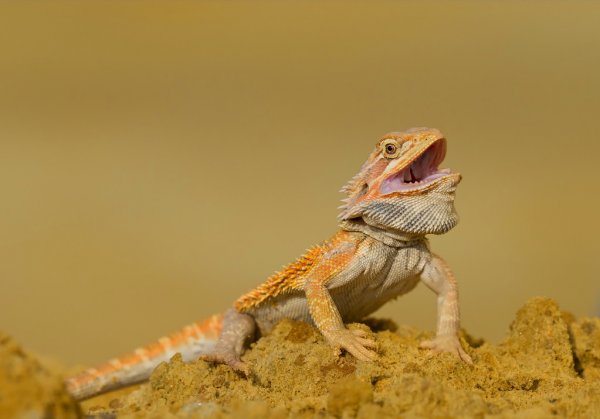ANIMAL: Inland/Central Bearded Dragon Pogona vitticeps Type of Animal: Agamid Habitat: Subtropical/tropical/temperate arid/semi-arid woodland, desert, savanna, scrubland, shrubland, arid rocky semi-desert, shore areas, dry forest, eucalyptus woodland, hummock grassland (w/ scattered trees) Location(s): Australia-SE N Territory, E South Australia, W Queensland, W New South Wales, far NW Victoria Appearance: Come in different colors-tan, gray, reddish-brown, brown, red, yellow, white, & orange, named for pouch-like projection on underside of neck/chin area, males have darker beards than females, flattened body, scaly throughout, large round eyes, spikes on sides, often yellowish around eyes & side of head Food/Diet: Insects, worms, insect larvae, grubs, spiders, slugs, greens, vegetables, fruit, legumes, berries, small mammals, eggs, small reptiles, plant material, grasses, leaves, weeds, flowers, snails, grains Status in Wild: Stable Conservation: Export from Australia banned in 1960s. Widely bred for pet trade & herpetoculture. Lifestyle: Solitary or small groups of a dominant male, 2-8 female, & ocassionally, 1-3 subordinate males. Additional Info: Called: Male Female Young: Hatchling Group: Colony Weight: Male: 1.1 lbs Female: 0.6 lbs Gestation: 2.5-4 months Life Span: 8-10 years in wild, 12-15 years in captivity Body Length: Male: 1.75-2 ft Female: 1.5 ft Young: 9 in Tail Length: Male: 10.5-12 in Female: 9 in Young: 4.5 in Main predators are larger lizards, snakes, predatory birds, dingoes, cats, foxes, pigs, & crocodiles. Adult beardies sometimes prey on juveniles. Dominant males highly territorial, sometimes fighting to the death. They love to bask in the sun. When stressed, scales become tense & spiky & throat/beard puffs out. When relaxed, scales flatter/smoother. Male beards darken when ready to breed. Beards on both sexes darken when stressed/threatened. Females lay 15-25 eggs per clutch. Puff up & make themselves look bigger to deter predators. Fun Fact(s): They can sleep standing up. One of most popular pet lizards due to ease of care, docility, & tamablity. These animals often head-bob-fast head-bobs indicate aggression/desire to fight (very common when males encounter each other or when males defend territory), slow head-bobs indicate submission (whether it’s same-sex or female to male. Males tend to be dominant), quick & jerky head-bobs indicate male’s ready to breed & receptive females will arm-wave. While they can’t regrow lost tails/limbs, they can regrow teeth. Can run at speeds of up to 9 mph if alarmed, often on 2 legs.

